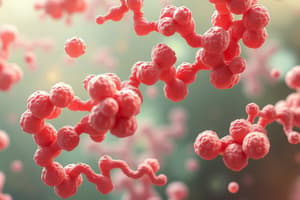Podcast
Questions and Answers
What path does a protein in the secretory pathway take, starting from its site of synthesis?
What path does a protein in the secretory pathway take, starting from its site of synthesis?
Proteins are synthesized in the rough ER, modified in the Golgi apparatus, and carried in secretory vesicles to the plasma membrane, where they are secreted.
Which of the following conclusions can be drawn from the pulse-chase experiment results?
Which of the following conclusions can be drawn from the pulse-chase experiment results?
- The proteins did not travel through the Golgi apparatus.
- The proteins traveled from lysosomes to endosomes.
- The proteins were secreted.
- The final destination of the proteins was the lysosome. (correct)
Proteins produced during the 'chase' phase of a pulse-chase experiment are labeled with radioactive material.
Proteins produced during the 'chase' phase of a pulse-chase experiment are labeled with radioactive material.
False (B)
What is the first step in a pulse-chase experiment?
What is the first step in a pulse-chase experiment?
What type of bond joins the monomers in a protein's primary structure?
What type of bond joins the monomers in a protein's primary structure?
The secondary structure of a protein results from _____?
The secondary structure of a protein results from _____?
Tertiary structure is NOT directly dependent on which of the following?
Tertiary structure is NOT directly dependent on which of the following?
What are surface appendages that allow a bacterium to stick to a surface?
What are surface appendages that allow a bacterium to stick to a surface?
What is the function of a bacterium's capsule?
What is the function of a bacterium's capsule?
Where is a bacterial cell's DNA found?
Where is a bacterial cell's DNA found?
The bacterial cell wall functions to _______.
The bacterial cell wall functions to _______.
Cellular homogenization is often incomplete, and the mixture has unbroken cells. These cells are found in _____?
Cellular homogenization is often incomplete, and the mixture has unbroken cells. These cells are found in _____?
What is the purpose of the blender in the preparation of liver mitochondrial enzymes?
What is the purpose of the blender in the preparation of liver mitochondrial enzymes?
What central theme of biology helps explain why various cells can look so different from one another?
What central theme of biology helps explain why various cells can look so different from one another?
Which of these organelles carries out cellular respiration?
Which of these organelles carries out cellular respiration?
The _____ is composed of DNA and protein.
The _____ is composed of DNA and protein.
Ribosomal subunits are manufactured by the _____?
Ribosomal subunits are manufactured by the _____?
Flashcards are hidden until you start studying
Study Notes
Protein Secretory Pathway
- Proteins are synthesized in the rough endoplasmic reticulum (ER) and undergo modifications in the Golgi apparatus.
- They are transported in secretory vesicles to the plasma membrane for secretion.
Pulse-Chase Experiment
- Radioactive protein tracking reveals that the final destination is the lysosome, as indicated by the last detection of radioactivity.
- Ten minutes of tracking shows proteins in the Golgi apparatus, transitioning to endosomes and lysosomes over time.
- Proteins produced during the "chase" are not labeled with radioactivity as nonradioactive materials are introduced.
Initial Steps of Pulse-Chase Experiment
- The experiment begins by incubating cells with a labeled molecule for pulse labeling of proteins.
Protein Structure
- Primary structure of proteins is formed by peptide bonds linking amino acids.
- Secondary structure arises from hydrogen bonds between electronegative atoms and hydrogen atoms with partial positive charges.
- Tertiary structure relies on interactions not directly dependent on peptide bonds.
Bacterial Structures
- Fimbriae are appendages that enable bacteria to adhere to surfaces.
- Capsules protect bacteria from environmental threats.
- Bacterial DNA is located in the nucleoid region due to the absence of a nucleus.
- The cell wall provides structural support and prevents osmotic stress.
Cell Homogenization
- Cellular homogenization can yield a mixture containing unbroken cells along with organelles.
- The first pellet in homogenization captures larger components like nuclei and whole cells.
- Blenders are used to create cell homogenates by breaking open cells and releasing organelles.
Biology Themes
- Structure-function correlation explains variations in cell appearance based on roles.
- Cells designed for different functions will exhibit different structural characteristics.
Cellular Respiration
- Mitochondria are the organelles responsible for converting chemical energy from organic molecules into ATP.
Chromatin
- Chromatin is composed of DNA wrapped around proteins, playing a key role in genetic material management.
Ribosomal Subunit Production
- Ribosomal subunits are synthesized within the nucleolus, essential for protein synthesis in cells.
Studying That Suits You
Use AI to generate personalized quizzes and flashcards to suit your learning preferences.



